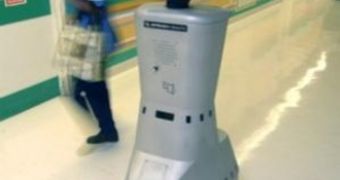A new invention could soon create an artificial bridge between trauma surgeons or other health care experts and wounded soldiers on the world's battlefields, if Remote Presence (RP7), a new medical robot prototype, lives up to the expectations everyone had for it. The purpose of the robot is to help on-scene personnel provide first-quality medical care, even if specialized staff is not present on the scene.
The “head” of RP7 is actually a display monitor, which shows the face of the health care expert who is giving advice, sitting comfortably behind his desk, thousands of miles away. All that trauma experts need for a connection is a web camera and a microphone, as well as a specific piece of software. RP7 is outfitted with speakers that can play back the voice of the man behind the screen himself, so as to comfort patients.
The system is designed to be used alongside real human help solely, as its manufacturer, InTouch Health, says that the machine will not touch the patients at all. Its main goal is to offer live feedback to specialists, so that they can guide the medical staff attending to the wounded soldier through complicated surgeries in real-time. Qualcomm will be providing the high bandwidth connection required for streaming so much information live, over such long distances.
The U.S. Army Training Center at Jackson, US, is currently the nervous center for the operation, which also involves the American Telemedicine Association. Most trauma care specialists that embark for Afghanistan and Iraq, as well as for other locations worldwide, are prepared at this center alone, which means that they always come in “short supply.” And that is one of the flaws that RP7 is trying to address – to make specialized health care readily available 24/7.
Future plans for the technology involve translating the system to mobile phones as well, which would mean that surgeons in the US could take calls and assist others not only when on call, but also at home or at the restaurant. Currently, the system is being tested at an undisclosed location in Iraq, and it will enter use as soon as the military is comfortable with its performances.

 14 DAY TRIAL //
14 DAY TRIAL //